N-1: Difference between revisions
Pbcjohnston (talk | contribs) Created N-1 page |
Pbcjohnston (talk | contribs) mNo edit summary |
||
| (8 intermediate revisions by 2 users not shown) | |||
| Line 1: | Line 1: | ||
[[File: | [[File:New Header N-class.jpg]] | ||
<div style="text-align: justify;"><span style="color:#00008B"> | [[File:N-1 controlroom under construction.jpg|left|500px]] | ||
<div style="text-align: justify;"><span style="color:#00008B">The control room of N-1 while under construction at the Todd yard in Seattle, January 22, 1917. The two large handwheels are for the bow diving planes (right) and the stern diving planes (left). There are two depth gauges between the wheels, both calibrated to 100 feet. The test depth of this boat was 200 feet, so going to 100 feet only was probably a safety measure. Submarine crews later advocated for depth gauges calibrated all the way to test depth. Their argument was that if they accidentally exceeded 100 feet they had no way of knowing how deep they were. Underneath the handwheels is the curved top of the port side ballast tanks. | |||
<small>Photo in the private collection of Ric Hedman</small> | <small>Photo courtesy of NARA Seattle.</small> | ||
[[File:Red bar sub new.jpg]] | |||
[[File:N-1 controlroom under construction upclose.jpg|left|500px]] | |||
A closeup of the photo above, showing details of the bow planes handwheel mechanism and the depth gauge. | |||
<small>Photo courtesy of NARA Seattle.</small> | |||
[[File:Red bar sub new.jpg]] | |||
[[File:N-1 engineroom under construction.jpg|left|500px]] | |||
A view of the N-1's engine room, looking forward, January 22, 1917. There is still work to be completed on the NELSECO 240V8FS engines. They were shipped to the yard fully assembled, then had to be partially disassembled to get them into the hull, with the finish work being completed after they were fully bolted down to the engine mounts. The walking deck plates between the engines need to be installed as well. | |||
<small>Photo courtesy of NARA Seattle.</small> | |||
[[File:Red bar sub new.jpg]] | |||
[[File:N-1 on launch day.jpg|left|500px]] | |||
N-1 on her launch day of December 30, 1916. She is being assisted by two small yard tugs, one of which was named the "Harold C". The Todd yard was located at the foot of Charles Street on the Seattle waterfront, just to the west of the present day Lumen Field, in a location that is now the Port of Seattle. | |||
<small>Photo from the Seattle Post-Intelligencer newspaper.</small> | |||
[[File:Red bar sub new.jpg]] | |||
[[File:N-1 with n-3 dry dock yard.jpg|left|500px]] | |||
N-1 and N-3 both moored at the fitting out pier at the Todd Drydock & Construction Company, Seattle, WA., May 9, 1917. Despite how the photo is stamped, by the date of the photo the Seattle Construction & Drydock Co. had been sold to the Todd company and renamed. N-1 had five more months before she was commissioned. The yard workers are busy with the periscope shears and bridge area. | |||
<small>Photo courtesy of NARA Seattle.</small> | |||
[[File:Red bar sub new.jpg]] | |||
[[File:N-1 seattle elliot bay.jpg|left|500px]] | |||
N-1 underway in Elliot Bay in the late summer of 1917, with the Seattle "skyline" in the background. She is likely on her builder's trials and does not yet have the bridge fairwater installed. | |||
<small>Photo courtesy of NARA Seattle.</small> | |||
[[File:Red bar sub new.jpg]] | |||
[[File:N-1 torpedoroom.jpg|left|500px]] | |||
The business end of the N-1's torpedo room showing the breech doors for each tube and the arrangement of the valves and gauges. | |||
<small>Photo in the private collection of Ric Hedman.</small> | |||
[[File:Red bar sub new.jpg]] | |||
[[File:N-1 Radio Shack via Bob Porterfield.jpg|left|500px]] | |||
N-1's radio shack, circa 1919. The SE-143 receiver is the topmost unit in the center of the photo. The DeForest Audion Detector is located below that. The two-stage amplifier on the desk beside the detector was added after the war when the boat was back at the base training students for the Submarine School. | |||
<small>Photo in the Harry Hoffman Collection via Bob Porterfield.</small> | |||
[[File:Red bar sub new.jpg]] | |||
[[File:N-1 on Thames Marine railway 2.jpg|left|500px]] | |||
The N-1 hauled out on the Thames Towboat Company's marine railway along the Thames River in New London, CT., approximately 1919. A marine railway is used to pull a ship out of the water to conduct repairs and work on the hull that can't be done while waterborne. At this time a drydock did not exist in the Groton/New London area, so the Navy contracted to use the civilian facility across the river from the base. The Submarine Base would eventually get its own marine railway, but not until the fall of 1941. | |||
This photo shows that Electric Boat followed the design of the previous L-class bow for the N-class. These boats had individual shutter doors for the torpedo tubes, not the trademark rotating bow cap seen on most of the other EB submarine designs. Two crewman can be seen lounging for the camera inside the superstructure of the open port side shutter doors. Above the heads of the men the port side rigged in bow plane can be seen, along with two of three conical hydrophones for the Y-tube sonar on the main deck. These hydrophones carried the nickname "rats". | |||
<small>Photo in the Harry Hoffman Collection via Bob Porterfield.</small> | |||
[[File:Red bar sub new.jpg]] | |||
[[File:N-1 on marine railway 1 - GM1 Bill Markee-MM2 Jack McKeon-GMC Ernie Reed.jpg|left|500px]] | |||
This photo was taken at the same time as the one above, on the civilian marine railway in New London, CT., 1919. From left to right is GM 1c Bill McKee, MM 2c Jack McKeon, and CGM Ernie Reed, the N-1's Chief of the Boat (COB). Chief Reed is wearing farmer's coveralls. Service on the pigboats was hard on uniforms, so the men tended to wear whatever they could find while underway or conducting work, and the service was tolerant of this practice, to a point. | |||
By this date N-1 has the permanent chariot-style bridge fairwater (above the men's heads). Two circular deadlight windows for the conning tower can be seen between the heads of McKeon and Reed. | |||
<small>Photo in the Harry Hoffman Collection via Bob Porterfield.</small> | |||
[[File:Red bar sub new.jpg]] | |||
[[File:N-1 torpedo loading.jpg|left|500px]] | |||
This caption is written on the back of this photo taken by Harry E. Hoffman: "''N-1's crew loads a torpedo at New London in 1918. Chief Gunner's Mate Earle Reed (in torn shirt), the Chief of the Boat, directs the operation. Facing the camera is Quartermaster First Class Hand and, in the background, is Chief Engineman Miskoski. Providing the muscle power for operating the loading crane is Dalieden, Electricians Mate Third Class. In the distance the submarines E-2, N-7, G-2, and H-2 can be seen. Also in the background is the fishing schooner Helvetia which served as a decoy for German U-boats during the war.''" | |||
It should be noted that it is likely that Chief Reed's first name was misspelled here, his first name was actually as Ernest. | |||
This weapon is a Bliss-Leavitt Mk 7. Handling it required great care. It weighed 1588 lbs and had a 205 lb TNT warhead on the nose. | |||
<small>Photo ID from Bob Porterfield who is in possession of this Harry E. Hoffman photo. The Library of Congress also has this photo.</small> | |||
[[File:Red bar sub new.jpg]] | |||
[[File:N-1 torpedo room crew.jpg|left|500px]] | |||
The torpedo room of the N-1 taken some time in 1918-1919. It shows some crew in the torpedo room posing for the camera. On the back of the photo these men are identified as, from left to right, Machinist's Mate Jack Richards, Ship's Cook Tannen Bloom, Signalman Head, and Gunner's Mate Lyons. | |||
<small>Photo Courtesy of John Parker, identification of the men by Robert Porterfield.</small> | |||
[[File:Red bar sub new.jpg]] | |||
[[File:N-1 and H-1 alongside tender Fulton in Great Salt Pond Block Island.jpg|left|500px]] | |||
N-1 and [[H-1|'''H-1''']] alongside the tender [https://www.navsource.net/archives/09/36/3601.htm '''Fulton (Submarine Tender No. 1)'''], moored in Great Salt Pond on Block Island off the coast of Connecticut, 1919. The boats were out in Block Island Sound conducting torpedo firing trials. | |||
<small>Photo in the Harry Hoffman Collection via Bob Porterfield.</small> | |||
[[File:Red bar sub new.jpg]] | |||
[[File:N-1 towing.jpg|left|500px]] | |||
N-1 on Long Island Sound on Easter Sunday, 1919 towing a small boat behind her with men aboard it. N-1 had fired a practice torpedo the previous day that had unfortunately sunk before it could be recovered. They returned the next day with a launch and divers. The weapon was located and retrieved. N-1 is shown here towing the diving launch behind her on the way back to New London, having successfully retrieved the torpedo. Information on this incident courtesy of Harry Hoffman and Bob Porterfield. | |||
The enclosed bridge fairwater was a lesson learned from war patrol experience in the north Atlantic during WWI. | |||
<small>U.S. Navy photo.</small> | |||
[[File:Red bar sub new.jpg]] | |||
[[File:N-1 and N-6 in Groton via Bob Porterfield.jpg|left|500px]] | |||
N-1 and [[N-6|'''N-6''']] alongside at Submarine Base New London, Groton, CT. 1919. The differences in design between the EB design N-1 and the Lake design N-6 are evident here. The conning tower fairwater, periscope shears, and bridge fairwater are completely different, along with the configuration of the superstructure. | |||
<small>Photo in the Harry Hoffman Collection via Bob Porterfield.</small> | |||
[[File:Red bar sub new.jpg]] | |||
[[File:N-1 crewman SM 1 Head aboard U-111 at Sub Base New London - 1919.jpg|left|500px]] | |||
N-1 crewman SM 1c Head posing aboard the captured German U-boat U-111 while alongside at Submarine Base New London, CT. 1919. U-111 had been a war prize turned over to the USN at the end of the war. She spent several years undergoing testing and evaluation at several locations along the Atlantic coast, before finally being expended as a target in July, 1921. | |||
<small>Photo in the Harry Hoffman Collection via Bob Porterfield.</small> | |||
[[File:Red bar sub new.jpg]] | |||
[[File:N-1 LCDR George B Fuller commanding officer.jpg|left|500px]] | |||
N-1's Commanding Officer LCDR George P. Fuller sitting on the T-shaped SC-tube sonar array on N-1's forward deck, approximately 1919. It was somewhat unusual in those days for a LCDR to command a small submarine like N-1. | |||
<small>Photo in the Harry Hoffman Collection via Bob Porterfield.</small> | |||
[[File:Red bar sub new.jpg]] | |||
[[File:N-1 Leaving the submarine base-Groton side of river to right via Bob Porterfield.jpg|left|500px]] | |||
N-1 underway in the Thames River, headed out to sea from Submarine Base New London, CT., 1919. The men are dressed warmly, indicating that this is a late fall, winter, or early spring photo. The open hatch leads to the torpedo room. CO LCDR George Fuller is atop the bridge. | |||
<small>Photo in the Harry Hoffman Collection via Bob Porterfield.</small> | |||
[[File:Red bar sub new.jpg]] | |||
[[File:N-1 Rigged for diving Bob Porterfield.jpg|left|500px]] | |||
A photo from N-1's bridge, just prior to diving, likely somewhere in Long Island or Block Island Sound, 1919. N-1 has some speed on, judged by the substantial wake she is throwing up. The bow planes are rigged out and the boat buttoned up for diving. Likely this was taken by LCDR Fuller just before pulling the plug. | |||
<small>Photo in the Harry Hoffman Collection via Bob Porterfield.</small> | |||
[[File:Red bar sub new.jpg]] | |||
[[File:N-1 at sea.jpg|left|500px]] | |||
N-1 pushing her nose through Atlantic swells. The N-class were small boats and they tended to be very wet even in a moderate sea. Date is unknown but is likely the early 1920's. It is possible that this photo was taken on the same underway as shown in the photo above, but this is obviously further out in the Atlantic as there is a much higher sea running. | |||
<small>Photo Courtesy of John Parker.</small> | |||
[[File:Red bar sub new.jpg]] | [[File:Red bar sub new.jpg]] | ||
| Line 12: | Line 156: | ||
Page created by:<br> | Page created by:<br> | ||
<small>Ric Hedman & David Johnston<br> | <small>Ric Hedman & David Johnston<br> | ||
©1999 - 2025 - PigBoats.COM<br> | |||
Mountlake Terrace, WA, Norfolk, VA<br> | Mountlake Terrace, WA, Norfolk, VA<br> | ||
webmaster | [mailto:webmaster@pigboats.com '''webmaster@pigboats.com''']</small> | ||
</center> | </center> | ||
[[File:Subs bottom line 2.jpg]] | [[File:Subs bottom line 2.jpg]] | ||
Latest revision as of 17:28, 2 July 2025
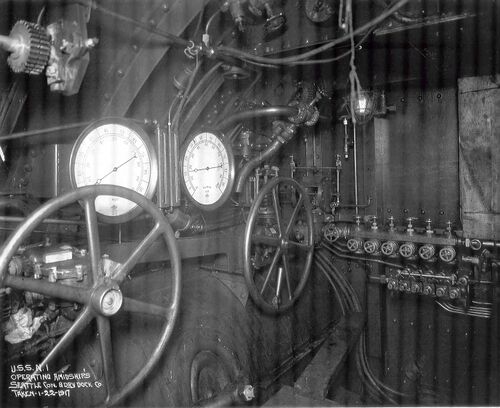
Photo courtesy of NARA Seattle.

A closeup of the photo above, showing details of the bow planes handwheel mechanism and the depth gauge.
Photo courtesy of NARA Seattle.
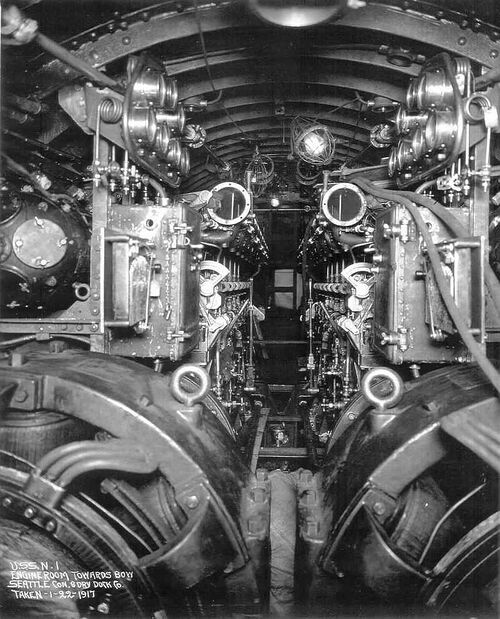
A view of the N-1's engine room, looking forward, January 22, 1917. There is still work to be completed on the NELSECO 240V8FS engines. They were shipped to the yard fully assembled, then had to be partially disassembled to get them into the hull, with the finish work being completed after they were fully bolted down to the engine mounts. The walking deck plates between the engines need to be installed as well.
Photo courtesy of NARA Seattle.
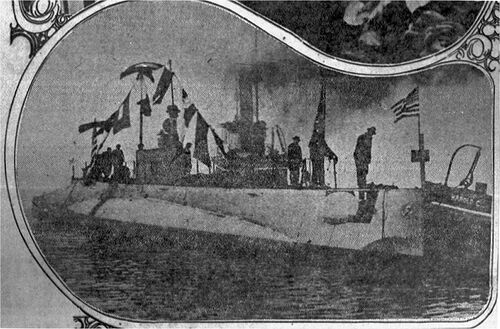
N-1 on her launch day of December 30, 1916. She is being assisted by two small yard tugs, one of which was named the "Harold C". The Todd yard was located at the foot of Charles Street on the Seattle waterfront, just to the west of the present day Lumen Field, in a location that is now the Port of Seattle.
Photo from the Seattle Post-Intelligencer newspaper.
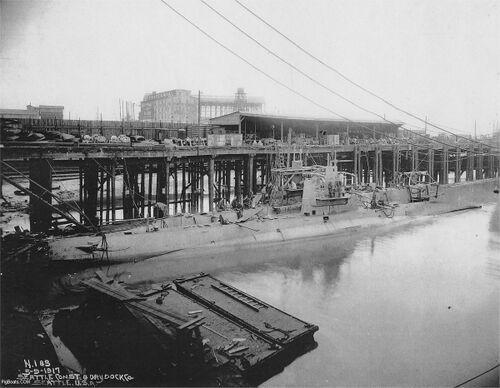
N-1 and N-3 both moored at the fitting out pier at the Todd Drydock & Construction Company, Seattle, WA., May 9, 1917. Despite how the photo is stamped, by the date of the photo the Seattle Construction & Drydock Co. had been sold to the Todd company and renamed. N-1 had five more months before she was commissioned. The yard workers are busy with the periscope shears and bridge area.
Photo courtesy of NARA Seattle.

N-1 underway in Elliot Bay in the late summer of 1917, with the Seattle "skyline" in the background. She is likely on her builder's trials and does not yet have the bridge fairwater installed.
Photo courtesy of NARA Seattle.

The business end of the N-1's torpedo room showing the breech doors for each tube and the arrangement of the valves and gauges.
Photo in the private collection of Ric Hedman.

N-1's radio shack, circa 1919. The SE-143 receiver is the topmost unit in the center of the photo. The DeForest Audion Detector is located below that. The two-stage amplifier on the desk beside the detector was added after the war when the boat was back at the base training students for the Submarine School.
Photo in the Harry Hoffman Collection via Bob Porterfield.

The N-1 hauled out on the Thames Towboat Company's marine railway along the Thames River in New London, CT., approximately 1919. A marine railway is used to pull a ship out of the water to conduct repairs and work on the hull that can't be done while waterborne. At this time a drydock did not exist in the Groton/New London area, so the Navy contracted to use the civilian facility across the river from the base. The Submarine Base would eventually get its own marine railway, but not until the fall of 1941.
This photo shows that Electric Boat followed the design of the previous L-class bow for the N-class. These boats had individual shutter doors for the torpedo tubes, not the trademark rotating bow cap seen on most of the other EB submarine designs. Two crewman can be seen lounging for the camera inside the superstructure of the open port side shutter doors. Above the heads of the men the port side rigged in bow plane can be seen, along with two of three conical hydrophones for the Y-tube sonar on the main deck. These hydrophones carried the nickname "rats".
Photo in the Harry Hoffman Collection via Bob Porterfield.

This photo was taken at the same time as the one above, on the civilian marine railway in New London, CT., 1919. From left to right is GM 1c Bill McKee, MM 2c Jack McKeon, and CGM Ernie Reed, the N-1's Chief of the Boat (COB). Chief Reed is wearing farmer's coveralls. Service on the pigboats was hard on uniforms, so the men tended to wear whatever they could find while underway or conducting work, and the service was tolerant of this practice, to a point.
By this date N-1 has the permanent chariot-style bridge fairwater (above the men's heads). Two circular deadlight windows for the conning tower can be seen between the heads of McKeon and Reed.
Photo in the Harry Hoffman Collection via Bob Porterfield.

This caption is written on the back of this photo taken by Harry E. Hoffman: "N-1's crew loads a torpedo at New London in 1918. Chief Gunner's Mate Earle Reed (in torn shirt), the Chief of the Boat, directs the operation. Facing the camera is Quartermaster First Class Hand and, in the background, is Chief Engineman Miskoski. Providing the muscle power for operating the loading crane is Dalieden, Electricians Mate Third Class. In the distance the submarines E-2, N-7, G-2, and H-2 can be seen. Also in the background is the fishing schooner Helvetia which served as a decoy for German U-boats during the war."
It should be noted that it is likely that Chief Reed's first name was misspelled here, his first name was actually as Ernest.
This weapon is a Bliss-Leavitt Mk 7. Handling it required great care. It weighed 1588 lbs and had a 205 lb TNT warhead on the nose.
Photo ID from Bob Porterfield who is in possession of this Harry E. Hoffman photo. The Library of Congress also has this photo.
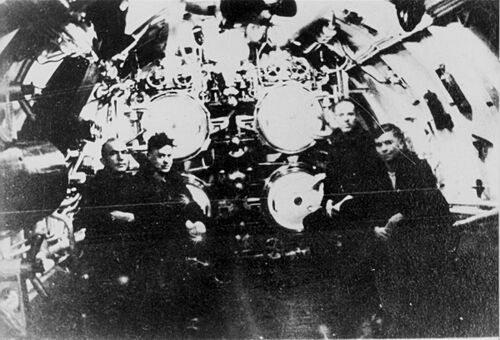
The torpedo room of the N-1 taken some time in 1918-1919. It shows some crew in the torpedo room posing for the camera. On the back of the photo these men are identified as, from left to right, Machinist's Mate Jack Richards, Ship's Cook Tannen Bloom, Signalman Head, and Gunner's Mate Lyons.
Photo Courtesy of John Parker, identification of the men by Robert Porterfield.

N-1 and H-1 alongside the tender Fulton (Submarine Tender No. 1), moored in Great Salt Pond on Block Island off the coast of Connecticut, 1919. The boats were out in Block Island Sound conducting torpedo firing trials.
Photo in the Harry Hoffman Collection via Bob Porterfield.
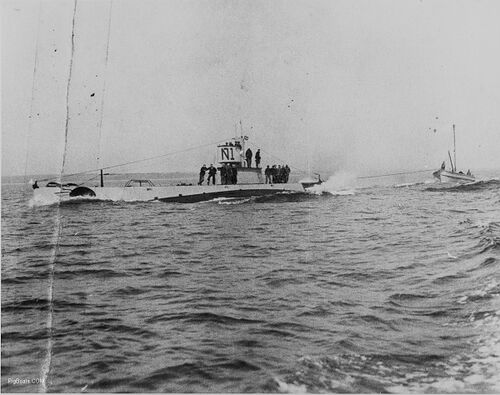
N-1 on Long Island Sound on Easter Sunday, 1919 towing a small boat behind her with men aboard it. N-1 had fired a practice torpedo the previous day that had unfortunately sunk before it could be recovered. They returned the next day with a launch and divers. The weapon was located and retrieved. N-1 is shown here towing the diving launch behind her on the way back to New London, having successfully retrieved the torpedo. Information on this incident courtesy of Harry Hoffman and Bob Porterfield.
The enclosed bridge fairwater was a lesson learned from war patrol experience in the north Atlantic during WWI.
U.S. Navy photo.

N-1 and N-6 alongside at Submarine Base New London, Groton, CT. 1919. The differences in design between the EB design N-1 and the Lake design N-6 are evident here. The conning tower fairwater, periscope shears, and bridge fairwater are completely different, along with the configuration of the superstructure.
Photo in the Harry Hoffman Collection via Bob Porterfield.

N-1 crewman SM 1c Head posing aboard the captured German U-boat U-111 while alongside at Submarine Base New London, CT. 1919. U-111 had been a war prize turned over to the USN at the end of the war. She spent several years undergoing testing and evaluation at several locations along the Atlantic coast, before finally being expended as a target in July, 1921.
Photo in the Harry Hoffman Collection via Bob Porterfield.

N-1's Commanding Officer LCDR George P. Fuller sitting on the T-shaped SC-tube sonar array on N-1's forward deck, approximately 1919. It was somewhat unusual in those days for a LCDR to command a small submarine like N-1.
Photo in the Harry Hoffman Collection via Bob Porterfield.

N-1 underway in the Thames River, headed out to sea from Submarine Base New London, CT., 1919. The men are dressed warmly, indicating that this is a late fall, winter, or early spring photo. The open hatch leads to the torpedo room. CO LCDR George Fuller is atop the bridge.
Photo in the Harry Hoffman Collection via Bob Porterfield.

A photo from N-1's bridge, just prior to diving, likely somewhere in Long Island or Block Island Sound, 1919. N-1 has some speed on, judged by the substantial wake she is throwing up. The bow planes are rigged out and the boat buttoned up for diving. Likely this was taken by LCDR Fuller just before pulling the plug.
Photo in the Harry Hoffman Collection via Bob Porterfield.
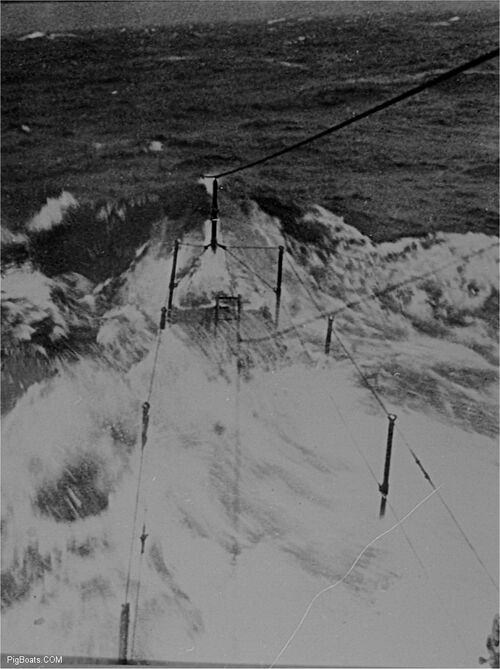
N-1 pushing her nose through Atlantic swells. The N-class were small boats and they tended to be very wet even in a moderate sea. Date is unknown but is likely the early 1920's. It is possible that this photo was taken on the same underway as shown in the photo above, but this is obviously further out in the Atlantic as there is a much higher sea running.
Photo Courtesy of John Parker.
Page created by:
Ric Hedman & David Johnston
©1999 - 2025 - PigBoats.COM
Mountlake Terrace, WA, Norfolk, VA
webmaster@pigboats.com
